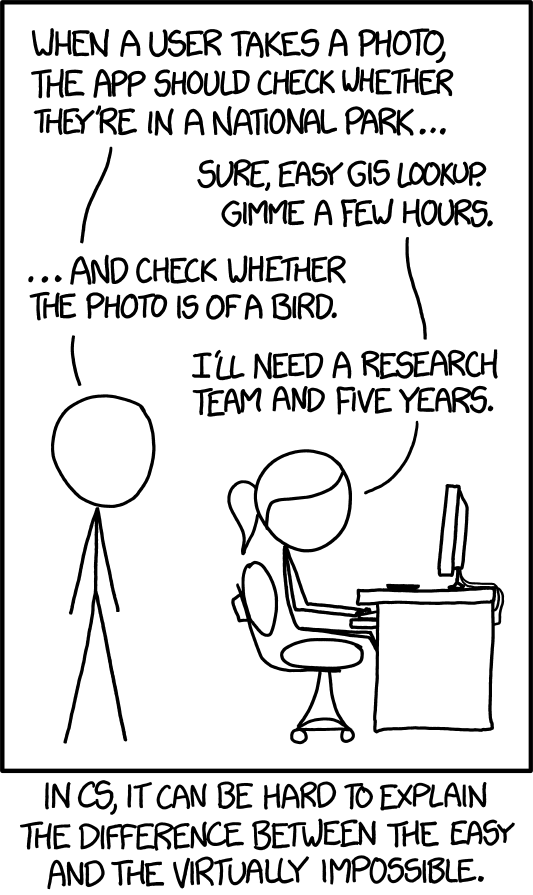Tuesday, 24th September 2024
Things I’ve Learned Serving on the Board of The Perl Foundation (via) My post about the PSF board inspired Perl Foundation secretary Makoto Nozaki to publish similar notes about how TPF (also known since 2019 as TPRF, for The Perl and Raku Foundation) operates.
Seeing this level of explanation about other open source foundations is fascinating. I’d love to see more of these.
Along those lines, I found the 2024 Financial Report from the Zig foundation really interesting too.
XKCD 1425 (Tasks) turns ten years old today (via) One of the all-time great XKCDs. It's amazing that "check whether the photo is of a bird" has gone from PhD-level to trivially easy to solve (with a vision LLM, or CLIP, or ResNet+ImageNet among others).

The key idea still very much stands though. Understanding the difference between easy and hard challenges in software development continues to require an enormous depth of experience.
I'd argue that LLMs have made this even worse.
Understanding what kind of tasks LLMs can and cannot reliably solve remains incredibly difficult and unintuitive. They're computer systems that are terrible at maths and that can't reliably lookup facts!
On top of that, the rise of AI-assisted programming tools means more people than ever are beginning to create their own custom software.
These brand new AI-assisted proto-programmers are having a crash course in this easy-v.s.-hard problem.
I saw someone recently complaining that they couldn't build a Claude Artifact that could analyze images, even though they knew Claude itself could do that. Understanding why that's not possible involves understanding how the CSP headers that are used to serve Artifacts prevent the generated code from making its own API calls out to an LLM!
nanodjango. Richard Terry demonstrated this in a lightning talk at DjangoCon US today. It's the latest in a long line of attempts to get Django to work with a single file (I had a go at this problem 15 years ago with djng) but this one is really compelling.
I tried nanodjango out just now and it works exactly as advertised. First install it like this:
pip install nanodjango
Create a counter.py file:
from django.db import models from nanodjango import Django app = Django() @app.admin # Registers with the Django admin class CountLog(models.Model): timestamp = models.DateTimeField(auto_now_add=True) @app.route("/") def count(request): CountLog.objects.create() return f"<p>Number of page loads: {CountLog.objects.count()}</p>"
Then run it like this (it will run migrations and create a superuser as part of that first run):
nanodjango run counter.py
That's it! This gave me a fully configured Django application with models, migrations, the Django Admin configured and a bunch of other goodies such as Django Ninja for API endpoints.
Here's the full documentation.
Updated production-ready Gemini models.
Two new models from Google Gemini today: gemini-1.5-pro-002 and gemini-1.5-flash-002. Their -latest aliases will update to these new models in "the next few days", and new -001 suffixes can be used to stick with the older models. The new models benchmark slightly better in various ways and should respond faster.
Flash continues to have a 1,048,576 input token and 8,192 output token limit. Pro is 2,097,152 input tokens.
Google also announced a significant price reduction for Pro, effective on the 1st of October. Inputs less than 128,000 tokens drop from $3.50/million to $1.25/million (above 128,000 tokens it's dropping from $7 to $5) and output costs drop from $10.50/million to $2.50/million ($21 down to $10 for the >128,000 case).
For comparison, GPT-4o is currently $5/m input and $15/m output and Claude 3.5 Sonnet is $3/m input and $15/m output. Gemini 1.5 Pro was already the cheapest of the frontier models and now it's even cheaper.
Correction: I missed gpt-4o-2024-08-06 which is listed later on the OpenAI pricing page and priced at $2.50/m input and $10/m output. So the new Gemini 1.5 Pro prices are undercutting that.
Gemini has always offered finely grained safety filters - it sounds like those are now turned down to minimum by default, which is a welcome change:
For the models released today, the filters will not be applied by default so that developers can determine the configuration best suited for their use case.
Also interesting: they've tweaked the expected length of default responses:
For use cases like summarization, question answering, and extraction, the default output length of the updated models is ~5-20% shorter than previous models.